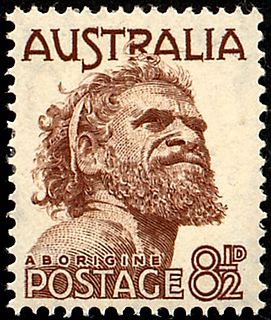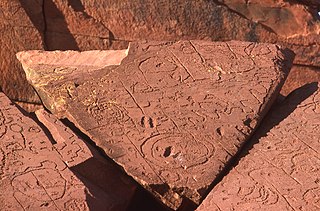Sources
The Dreamtime (1965) Ainslie Roberts and Charles P Mountford, Adelaide, Rigby Pty Ltd.
In Australian Aboriginal mythology, Wuluwaid (see also Wuluwait) is a rain god. He is a god from northern Arnhem Land (northern Australia) and is known to work with Bunbulama as a rainmaker. He is also recorded by Charles Mountford and Ainslie Roberts as a boatman who ferries the souls of the dead to Purelko, the aboriginal afterlife.
The Dreamtime (1965) Ainslie Roberts and Charles P Mountford, Adelaide, Rigby Pty Ltd.
In Aboriginal mythology, the Inapertwa are the simple, ancestral creatures with which the Numakulla modelled all life on Earth, which they then formed into human beings. The "totems" of the Arrernte are named after individual Inapertwa formed into animals, then into humans.

Ainslie is a leafy suburb of Canberra, Australia in the North Canberra district.

The Adnyamathanha are a contemporary Aboriginal Australian people of the northern Flinders Ranges, South Australia, formed as an aggregate of several distinct peoples. Strictly speaking the ethnonym Adnyamathanha was an alternative name for the Wailpi, but the grouping also includes the Guyani, Jadliaura, Pilatapa and sometimes the Barngarla peoples. The origin of the name is in the words "adnya" ("rock") and "matha".
James Ainslie (1787–1844) was a Scottish shepherd, best known as the first overseer of the property known as Duntroon in the Australian Capital Territory. During his time on the Limestone Plains he is said to have had a relationship with an Aboriginal woman. After 10 years at Duntroon, Ainslie returned to Scotland and after numerous offences committed suicide in jail in 1844.

A message stick is a form of graphic communication traditionally used by Aboriginal Australians, carried by messengers over long distances to contribute to the verbal message. Although styles vary, it is generally a length of wood with motifs engraved on it conveying aspects of the message. The sticks were used across continental Australia, and used to convey messages between Aboriginal nations, clans and language groups and even within clans. In the 1880s, they became objects of anthropological study, but there has been little research on them published since then.

Henbury Meteorites Conservation Reserve is a protected area in the Northern Territory of Australia located in the locality of Ghan.
Charles Pearcy Mountford was an Australian anthropologist and photographer. He is known for his pioneering work on Indigenous Australians and his depictions and descriptions of their art. He also led the American-Australian Scientific Expedition to Arnhem Land. His final book, Nomads of the Australian Desert, was the subject of an important court case due to its inclusion of culturally restricted content.
Ngaatjatjarra is an Australian Aboriginal dialect of the Western Desert language. It is spoken in the Western Desert cultural bloc which covers about 600 000 square kilometres of the arid central and central-western desert. It is very similar to its close neighbours Ngaanyatjarra, Pitjantjatjara and Pintupi, with which it is highly mutually intelligible.
Ainslie Roberts was an Australian painter, photographer, and commercial artist. He is best known for his interpretations of Aboriginal legends in his Dreamtime books, written in collaboration with ethnologist/anthropologist Charles Mountford.

Gwoya Tjungurrayi, also spelt Gwoya Jungarai, Gwoya Djungarai and Gwoja Tjungarrayi, was a Walpiri-Anmatyerre man of the Northern Territory of Australia. Also known by his nickname One Pound Jimmy, he became the first Aboriginal person to be featured on an Australian postage stamp. The Electoral division of Gwoja was named after him.
Wuluwait is a god from northern Arnhem Land and is known to work with Bunbulama as a rainmaker. He is also recorded by Charles Mountford and Ainslie Roberts as a boatman who ferries the souls of the dead to Purelko, the aboriginal afterlife.

Nepabunna, also spelt Nipapanha, is a small community in the northern Flinders Ranges in north-eastern South Australia, about 600 kilometres (370 mi) north of Adelaide. It is located just west of the Gammon Ranges, and the traditional owners are the Adnyamathanha people.

The Ewaninga Conservation Reserve is a protected area in the Northern Territory of Australia consisting of an area of low sand dunes, rocky outcrops and a claypan about 35 kilometres (22 mi) south of Alice Springs. It is significant because of a large number of Aboriginal rock carvings.
In February 1948, a team of Australian and American researchers and support staff came together in northern Australia to begin, what was then, one of the largest scientific expeditions ever to have taken place in Australia—the American-Australian Scientific Expedition to Arnhem Land. Today it remains one of the most significant, most ambitious and least understood expeditions ever mounted.
Donald Robert Stuart was an Australian novelist whose works include stories with Aboriginal backgrounds, and a series recounting his experience as a prisoner of war in Burma in World War II.

The Worrorra, also written Worora, are an Aboriginal Australian people of the Kimberley area of north-western Australia.
The Bininj are an Aboriginal Australian people of Western Arnhem land in the Northern Territory. The sub-groups of Bininj are sometimes referred to by the various language dialects spoken in the region, that is, the group of dialects known as Bininj Gun-Wok; so the people may be named Gunwinggu, the Kuninjku, Kundjeyhmi (Gundjeihmi), Manyallaluk Mayali, Kundedjnjenghmi and Kune groups. In addition, there are clan groups such as the Mirrar who are prominent in matters relating to looking after the traditional lands.
Garkain is a legendary creature in Australian Aboriginal mythology said to haunt the dense jungle along the Liverpool River in the Northern Territory. Should an unwary traveler enter his domain, Garkain swoops down from the trees on his leathery wings and envelops them.
The Ngaliya (Ngalia) are an indigenous Australian people of the Northern Territory who speak a dialect of the Warlpiri language. They are not to be confused with the Ngalia of the Western Desert.
Dick Binyinyuwuy Djarrankuykuy (c. 1928–1982) was a leading Aboriginal artist from the island of Milingimbi off the coast of the Northern Territory of Australia. He belonged to the Djarrankuykuy clan of the Djambarrpuyngu people. During World War II he was among the group of Aboriginal men enlisted by Squadron Leader Donald Thomson for the Northern Territory Special Reconnaissance Unit to protect Australia's northern shoreline from Japanese invasion. He became an artist after the war, in the 1950s.